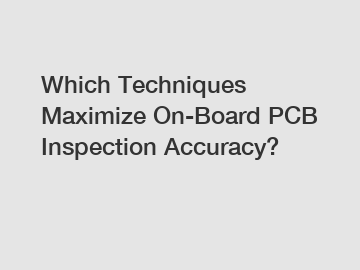Which Techniques Maximize On-Board PCB Inspection Accuracy?
When it comes to printed circuit boards (PCBs), the accuracy of inspection plays a crucial role in ensuring the functionality and reliability of electronic devices. Manufacturers and engineers are constantly seeking ways to boost inspection accuracy to minimize defects and improve overall product quality. In this article, we will explore some of the most effective techniques that maximize on-board PCB inspection accuracy. From stringent quality control measures to advanced inspection technologies, these methods have proven to be highly successful in achieving impeccable results.
1. Utilizing Automated Optical Inspection (AOI) Systems:
Automated Optical Inspection (AOI) systems are rapidly gaining popularity in the PCB industry due to their ability to rapidly and accurately inspect PCB assemblies. AOI applies powerful imaging technologies to analyze PCBs for defects such as missing components, skewed parts, soldering errors, or incorrect component placements. This technology leverages advanced algorithms to accurately detect even the most minute defects, ensuring unparalleled inspection accuracy.

2. Implementing X-ray Inspection for Hidden Defects:
While AOI systems excel in surface inspections, they may be limited when it comes to analyzing hidden defects within the PCB assembly, such as solder joint quality or component connections. X-ray inspection is an excellent complementary technique that allows manufacturers to penetrate the layers of a PCB for more thorough and comprehensive analysis. By identifying hidden faults, X-ray inspection significantly enhances the accuracy of defect detection, ultimately resulting in improved product quality.
3. Applying Flying Probe Testing:
Flying probe testing is a non-intrusive and highly efficient technique for inspecting PCBs during both prototype and production phases. This method involves the use of automated probes that move along the board's surface, testing various electrical connections. Flying probe testing ensures that critical connectivity points, such as vias, pads, or traces, are functioning correctly. Its high-speed and high-precision nature make it an ideal solution for both single-sided and double-sided PCB inspections.
4. Employing 3D Inspection Technology:
Traditional 2D inspection methods may sometimes fall short in accurately assessing complex components or densely populated boards. 3D inspection technology, on the other hand, provides a more precise evaluation by capturing the height profiles of components, solder joints, and solder paste deposits. This technique enables manufacturers to identify potential defects that could be missed by traditional 2D inspections, subsequently enhancing the overall accuracy of PCB inspections.
5. Implementing Machine Learning and Artificial Intelligence:
Harnessing the power of machine learning and artificial intelligence is a cutting-edge approach to enhance on-board PCB inspection accuracy. By training algorithms with vast amounts of data, these technologies can identify patterns, learn from experience, and improve over time. Machine learning algorithms can detect recurrent defects, minimize false positives, and even predict potential issues, ultimately leading to more accurate and efficient inspections with minimal human intervention.
6. Prioritizing Proactive Quality Control Measures:
While advanced inspection technologies play a significant role in maximizing accuracy, it's crucial not to overlook the importance of proactive quality control measures. Emphasizing meticulous design and manufacturing processes, rigorous component sourcing, and detailed documentation helps prevent defects from occurring in the first place. By prioritizing quality control throughout the entire production cycle, manufacturers can minimize the need for rigorous inspection while ensuring the accuracy of the assembled PCB.
Conclusion:
Achieving optimal on-board PCB inspection accuracy is vital to ensure the reliability and functionality of electronic devices. By leveraging advanced technologies such as AOI systems, X-ray inspection, flying probe testing, and 3D inspection, manufacturers can identify defects that may be missed by traditional manual inspections. Additionally, the integration of machine learning and artificial intelligence further enhances accuracy by continually improving and refining the detection process. Moreover, proactive quality control measures laid out during the design and manufacturing stages play a pivotal role in preventing defects. Ultimately, the combination of these techniques can significantly improve inspection accuracy, leading to higher-quality PCB assemblies and greater customer satisfaction.
Contact us to discuss your requirements of Uv Laser Cutting, Intelligent Counting, semiconductor x ray inspection. Our experienced sales team can help you identify the options that best suit your needs.

Comments
0